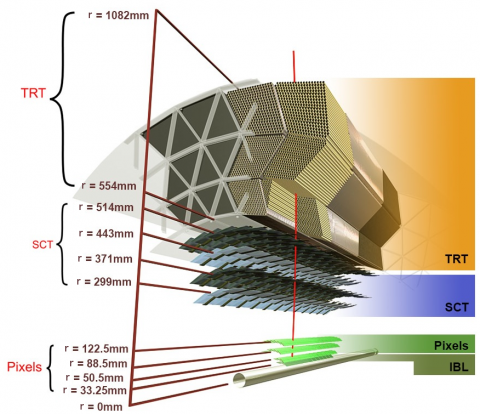Inner Tracking Detector
The image was taken from: recent paper. More images (without IBL) can be found on this CDS link
Latest update: 01.12.2017 Version 0
Design facts and figures
Few numbers taken from ATLAS Fact Sheet 2011, updated using LS1 LHCC reports 2013-2015
Pixel Detector:
In Run 1 the pixel detector covered a radius from 12cm to 5cm around the beam:
- 80 million pixels (80 million channels). Area 1.7 m2 . 15 kW power consumption.
- Barrel has 1744 modules (10 cm2 ) with 46 080 readout channels per module
- Pixel size 50 x 400 microns2 . Resolution 14 x 115 microns2 .
- 3 pixel disks ( in each endcap ) have 6.6 millions channels
- 3 barrel layers: 1456 modules (i.e. 67M)
- 3 disks in each end-cap: 288 modules (i.e 13M)
The idea to insert an additional layer inner - the IBL - made of novel 3D sensors, turned into a project in 2008. It was installed during LS1 [ May 2014 ].
- 14 staves mounted on a new Be beam pipe at r=3.3 cm, 2mm away from the previously innermost pixel layer.
- The IBL provides a 4th measurement, hence better resolution and performance in high pileup, with improved radiation hardness
- 2 sensor technologies: planar sensors in the central region, 3D pixel on the outside [ a step towards the tracker upgrade, ITK ]
- The installation of the IBL implied the extraction of the full pixel detector, a delicate operation which required the removal of the small wheel of side C (“big opening”). Once in a clean room, the rest of the pixel detector was also refurbished: the detector read-out was back to 99% operational fraction at the start of run 2, similar to when the pixel detector was installed in 2007 (was 95% at the end of Run-1). In the cavern and control room, new service panels, opto-boards, power supply system and fibers were installed.
Diamond beam monitor : Installed in the pixel detector, powered and read out through the IBL system, this detector monitors luminosity for bunches which ATLAS does not trigger on.
Semiconductor Tracker (SCT)
- A silicon microstrip tracker consisting of 4088 two-sided modules and over 6 million implanted readout strips (6 million channels).
- 60 m2 of silicon distributed over 4 cylindrical barrel layers and 18 planar endcap slices.
- Readout strips every 80 microns on the silicon, allowing the positions of charged particles to be recorded to an accuracy of 17 microns per layer (in the direction transverse to the strips).
Transition Radiation Tracker (TRT):
The basic detector element is a straw tube with 4mm diameter, in the center a 0.03 mm diameter gold-plated tungsten wire. Precision measurement of 0.17 mm (particle track to wire). Provides information on the particle type that flew through the detector, i.e if it is an electron or pion.
- 350 000 read-out channels. Volume 12 m2
- 50 000 straws in Barrel, each straw 144 cm long. The ends of a straw are readout separately.
- 250 000 straws in both endcaps, each straw 39 cm long
In run 2: use Argon instead of Xenon for detector parts less critical for particle identification. Reason for this is that leaks developed in the active gas exit pipes during Run 1, which could not all be fixed (barrel not accessible). New gas flow control system to manage and optimize Xe losses.
Stories, images and videos
- Photos on the ATLAS web site detector presentation
- Photos: "best of ATLAS" series on the Inner Detector construction and installation
- ATLAS public web site updates tagged as inner-detector tell some of the stories
- For ATLAS insiders & alumni: Daniel Froidevaux, Phillip Allport and Claudia Gemme's talks at the ATLAS25 celebration
- For an advanced audience: Isabelle Wingerter's 2017 summer student 3rd detector lecture [ see here the full list ]
Run 2 achievements :
Thanks to the pixel 4th layer (IBL), new types of analyses were made possible (e.g. search for long lived particles) and presentated at Moriond 2017. Check the full story in the ATLAS web site updates tagged as IDTR group and specially the "Quest for the lost arc" briefing.
Operational experience and plans for upgrade were presented at the Sept 2017 VERTEX conference :
- 2017 approved plots on pile up are here. In 2017, the up to 80 simultaneous interactions per beam crossing were observed, with an average <mu> = 38.3 . The current ATLAS trigger limits are around <mu> = 60, and ATLAS is using levelling at the beginning of each LHC fill. For comparisons, initial targets were about 23.
- The performance of the LHC far beyond original specs [ Luminosity of 2 1034 cm-2s-1 instead of 1034 ] poses a substantial challenge to the detectors, in terms of bandwidth in particular. In 2016 the readout rate of the Layer 2 was doubled [ from 40 to 80 Mbps ], by replacing the original readout boards by IBL boards. In 2017 layer 1 was also upgraded, to run at 160 Mbps. Thresholds were adjusted to reduce the data volume and occupancy by 30%, without loss of efficiency [ sub-percent level ]. The effect of radiation damage is minimised by keeping the detector cold.
- For a few words on the issues met in run 2 for tracking check the briefing "Charged particle reconstruction at the energy frontier" and references therein
Future challenges
The complete LHC accelerator and detector upgrades are expected to be progressively installed during the next two major shutdowns of the accelerator complex, defined as LS2 (currently scheduled to take place in 2019-2020 and to last for 24 months) and LS3 (currently scheduled to take place in 2024-2026 and to last for 30 months).
2015 ATLAS Phase-II Upgrade plans: the 2012 upgrade LoI (letter of intent) needs to be revised, as the expected average number of interactions per beam crossing increased from ~140 to ~200.
LS2: commissionning of the Fast TracKer trigger (FTK) uses hardware track reconstruction based on associative memories to perform reconstruction of tracks with transverse momentapT≥1 GeV, which are then sent to the Event Filter (EF) processing farm. This addition to the trigger provides high-quality tracking information as an input to the HLT, allowing complex track-based triggerdecisions to be made very rapidly.
LS3: the ATLAS tracking detector will be fully replaced. The new detector is called ITk and is currently under design, it consists of pixel and strips silicon detectors. The ITk strip TDR was approved in May 2017. The ITk pixel TDR is on track for submission by the end of 2017.
How much of it can we see @P1 ?
Nothing, except for the detector elements in the Visitor Center and the shifters desks in the control room.
ITk chips are tested in beams in Prevessin [ H6 ] and Desy.

